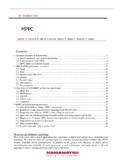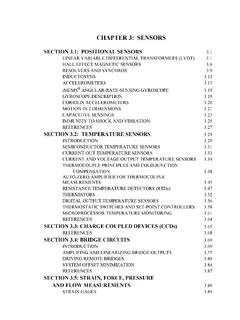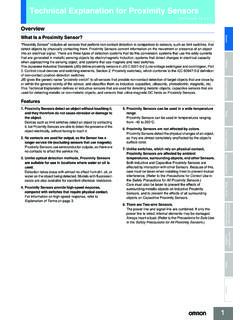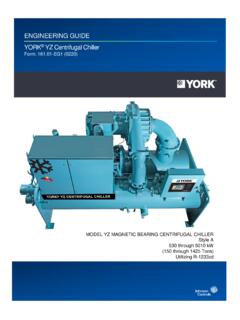Transcription of PHOTOMULTIPLIER TUBES - Hamamatsu Photonics
1 PHOTOMULTIPLIER TUBESPHOTON IS OUR BUSINESSB asics and Applications THIRD EDITION (Edition 3a) 2007 Hamamatsu Photonics K. K. PHOTOMULTIPLIER TUBES PHOTOMULTIPLIER Tube Modules 2007 Hamamatsu Photonics K. detection technolgy is a powerful tool that provides deeper understanding of more sophisticatedphenomena. Measurement using light offers unique advantages: for example, nondestructive analysis of asubstance, high-speed properties and extremely high detectability. Recently, in particular, such advanced fieldsas scientific measurement, medical diagnosis and treatment, high energy physics, spectroscopy and biotech-nology require development of photodetectors that exhibit the ultimate in various performance or light sensors can be broadly divided by their operating principle into three major catego-ries: external photoelectric effect, internal photoelectric effect and thermal types.
2 The external photoelectriceffect is a phenomenon in which when light strikes a metal or semiconductor placed in a vacuum, electronsare emitted from its surface into the vacuum. PHOTOMULTIPLIER TUBES (often abbreviated as PMT) make use ofthis external photoelectric effect and are superior in response speed and sensitivity (low-light-level detection).They are widely used in medical equipment, analytical instruments and industrial measurement sensors utilizing the internal photoelectric effect are further divided into photoconductive types andphotovoltaic types. Photoconductive cells represent the former, and PIN photodiodes the latter. Both typesfeature high sensitivity and miniature size, making them well suited for use as sensors in camera exposuremeters, optical disk pickups and in optical communications. The thermal types, though their sensitivity is low,have no wavelength-dependence and are therefore used as temperature sensors in fire alarms, intrusion alarms, handbook has been structured as a technical handbook for PHOTOMULTIPLIER TUBES in order to providethe reader with comprehensive information on PHOTOMULTIPLIER handbook will help the user gain maximum performance from PHOTOMULTIPLIER TUBES and show how toproperly operate them with higher reliability and stability.
3 In particular, we believe that the first-time user willfind this handbook beneficial as a guide to PHOTOMULTIPLIER TUBES . We also hope this handbook will be usefulfor engineers already experienced in PHOTOMULTIPLIER TUBES for upgrading performance furnished by Hamamatsu Photonics is believed to be reliable. However, no responsibility isassumed for possible inaccuracies or omission. The contents of this manual are subject to change withoutnotice. No patent rights are granted to any of the circuits described herein. 2007 Hamamatsu Photonics K. K. 2007 Hamamatsu Photonics K. 1 INTRODUCTION .. of This Manual .. Units .. regions and units .. of light intensity .. of photocathodes .. of PHOTOMULTIPLIER TUBES .. 10 References in Chapter 1 .. 12 CHAPTER 2 BASIC PRINCIPLES OFPHOTOMULTIPLIER TUBES .. Emission.
4 Trajectory .. Multiplier (Dynode Section) .. 18 References in Chapter 2 .. 19 CHAPTER 3 BASIC OPERATING METHODSOF PHOTOMULTIPLIER TUBES .. PHOTOMULTIPLIER TUBES .. to make the proper selection .. devices .. 23 High-voltage power supply .. 23 Voltage-divider circuit .. 24 Housing .. 26 Integral power supply module .. methods (connection circuits) .. 28 2007 Hamamatsu Photonics K. 4 CHARACTERISTICS OFPHOTOMULTIPLIER TUBES .. Characteristics of Photocathodes .. materials .. 30(1) Cs-I .. 30(2) Cs-Te .. 30(3) Sb-Cs .. 30(4) Bialkali (Sb-Rb-Cs, Sb-K-Cs) .. 30(5) High temperature, low noise bialkali (Sb-Na-K) .. 31(6) Multialkali (Sb-Na-K-Cs) .. 31(7) Ag-O-Cs .. 31(8) GaAsP (Cs) .. 31(9) GaAs (Cs) .. 31(10) InGaAs (Cs) .. 31(11) InP/InGaAsP(Cs), InP/InGaAs(Cs) .. 31 Reflection mode photocathodes.
5 34 Transmission mode photocathodes .. materials .. 36(1) MgF2 crystal .. 36(2) Sapphire .. 36(3) Synthetic silica .. 36(4) UV glass (UV-transmitting glass) .. 36(5) Borosilicate glass .. response characteristics .. 37(1) Radiant sensitivity .. 37(2) Quantum efficiency .. 37(3) Measurement and calculation of spectral response characteristics .. 38(4) Spectral response range (short and long wavelength limits) .. sensitivity .. 38(1) Cathode luminous sensitivity .. 39(2) Anode luminous sensitivity .. 40(3) Blue sensitivity index and red-to-white ratio .. sensitivity and spectral response .. Characteristics of Dynodes .. types and features .. 43(1) Circular-cage type .. 44(2) Box-and-grid type .. 44(3) Linear-focused type .. 44(4) Venetian blind type .. 44(5) Mesh type .. 44(6) MCP (Microchannel plate).
6 44(7) Metal channel dynode .. 44(8) Electron bombardment type .. efficiency and gain (current amplification) .. 45(1) Collection efficiency .. 45(2) Gain (current amplification) .. of PHOTOMULTIPLIER TUBES .. characteristics .. 48(1) Rise time, fall time and electron transit time .. 49(2) TTS (transit time spread) .. 50(3) CTTD (cathode transit time difference) .. 52(4) CRT (coincident resolving time) .. 54(1) Cathode linearity .. 54(2) Anode linearity .. 54(3) Linearity measurement .. 59(1) Spatial uniformity .. 60(2) Angular response .. 63(1) Drift (time stability) and life characteristics .. 63(2) Aging and warm-up .. 65(1) Light hysteresis .. 65(2) Voltage hysteresis .. 66(3) Reducing the hysteresis .. current .. 67(1) Causes of dark current .. 67(2) Expression of dark current .. ratio of PHOTOMULTIPLIER TUBES .
7 77 Types of afterpulses .. dependence .. 78 References in Chapter 4 .. 81 CHAPTER 5 HOW TO USE PHOTOMULTIPLIER TUBESAND PERIPHERAL CIRCUITS .. Circuits .. operation of voltage-divider circuits .. 84 2007 Hamamatsu Photonics K. grounding and cathode grounding .. current and output linearity .. 86(1) DC-operation output linearity and its countermeasures .. 86(2) Pulse-operation output linearity and its countermeasures .. distribution in voltage-divider circuits .. 90(1) Voltage distribution in the anode and latter stages .. 90(2) Voltage distribution for the cathode and earlier stages .. for fast response circuits .. fast-response voltage-divider circuit .. output linearity voltage-divider circuit (1) .. output linearity voltage-divider circuit (2) .. circuit .. Anode sensitivity adjustment circuits.
8 Precautions when fabricating a voltage-divider circuit .. 100(1) Selecting the parts used for a voltage-divider circuit .. 100(2) Precautions for mounting components .. a High-Voltage Power Supply .. to an External Circuit .. an output signal .. of a coupling capacitor .. conversion for PHOTOMULTIPLIER tube output ..105(1) Current-to-voltage conversion using load resistance .. 105(2) Current-to-voltage conversion using an operational amplifier .. 107(3) Charge-sensitive amplifier using an operational amplifier .. circuit for a fast response PHOTOMULTIPLIER tube .. shield .. shield .. shield .. 113(1)Shielding factor of magnetic shield case and orientation of magnetic (2) Saturation characteristics .. 116(3) Frequency characteristics .. 118(4) Edge effect .. 119(5) PHOTOMULTIPLIER tube magnetic characteristics and shielding effect.
9 119(6) Handling the magnetic shield case .. 122 References in Chapter 5 .. 123 2007 Hamamatsu Photonics K. 6 PHOTON COUNTING .. and Digital (Photon Counting) Modes .. of Photon Counting .. Method and Characteristics of Photon Counting ..129(1) Circuit configuration .. 129(2) Basic characteristics of photon counting .. 129 References in Chapter 6 .. 134 CHAPTER 7 SCINTILLATION COUNTING .. and PHOTOMULTIPLIER TUBES .. 139(1) Energy resolution .. 139(2) Relative pulse height .. 142(3) Linearity .. 142(4) Uniformity .. 144(5) Stability .. 145(6) Noise .. 146(7) Plateau characteristic .. 148 References in Chapter 7 .. 151 CHAPTER 8 PHOTOMULTIPLIER TUBE MODULES .. Are PHOTOMULTIPLIER Tube Modules? .. of Power Supply Circuits .. 154(1) Power supply circuits .. 154(2) Ripple noise .. 156(3) Settling time.
10 Output Type and Voltage Output Type .. 157(1) Connection method .. 157(2) Gain adjustment .. 157(3) Current output type module .. 158(4) Voltage output type module .. Counting Head .. 159(1) Output characteristics .. 159(2) Counting sensitivity .. 159(3) Count linearity .. 160(4) Improving the count linearity .. 160(5) Temperature characteristics .. 161(6) Photon counting ASIC (Application Specific Integrated Circuit) .. 162 2007 Hamamatsu Photonics K. Function .. 163(1) Gate noise .. 163(2) Extinction ratio .. CPU and IF Type .. 165(1) Photon counting type .. 165(2) Charge amplifier and AD converter type .. 166 References in Chapter 8 .. 166 CHAPTER 9 POSITION SENSITIVEPHOTOMULTIPLIER TUBES .. PHOTOMULTIPLIER TUBES .. channel dynode type multianode PHOTOMULTIPLIER TUBES ..169(1) Structure.


















